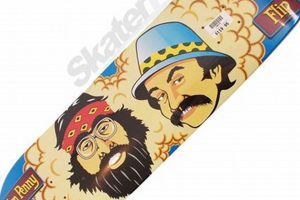Miniature skateboard platforms, typically crafted from wood or plastic, provide a scaled-down representation of their full-sized counterparts. These items are designed for manipulation using one’s fingers, mimicking the actions performed on a standard skateboard. An example is a small wooden board, complete with grip tape and truck hardware, used to execute tricks on a miniature ramp.
The appeal lies in the development of fine motor skills, dexterity, and hand-eye coordination. Furthermore, they offer a tangible connection to the skateboarding culture, allowing enthusiasts to practice and experiment with maneuvers in a controlled environment. Their historical context involves a transition from simple novelty items to sophisticated tools for both recreation and skill refinement.
Subsequent discussion will elaborate on construction materials, design variations, the influence of professional skateboard brands, and the evolving landscape of competitive events associated with these diminutive boards.
Guidance on Finger Skate Decks
The subsequent recommendations aim to provide guidance for selecting, maintaining, and utilizing finger skate decks effectively, thereby maximizing enjoyment and promoting skill development.
Tip 1: Material Selection: Prioritize decks constructed from multiple plies of wood. These exhibit enhanced durability and a more realistic feel compared to plastic alternatives. For example, a five-ply maple deck offers superior pop and longevity.
Tip 2: Grip Tape Application: Ensure the grip tape is applied smoothly and uniformly to the deck surface. Air bubbles can impede finger traction and hinder trick execution. Precise application, utilizing a specialized tool if necessary, is crucial.
Tip 3: Truck Adjustment: Regularly inspect and adjust the tightness of the trucks. Looser trucks facilitate easier turning and carving, while tighter trucks provide greater stability for flat ground tricks. Experiment to determine the optimal setting based on individual preference.
Tip 4: Wheel Maintenance: Clean the wheels periodically to remove dirt and debris that can compromise rolling performance. A specialized wheel cleaning solution can be employed to restore grip and smooth rotation.
Tip 5: Ramp Selection: Opt for ramps with smooth transitions and consistent surfaces. Uneven or poorly constructed ramps can negatively impact trick execution and potentially damage the deck. Investing in quality ramps is advisable.
Tip 6: Finger Placement: Experiment with different finger placements to optimize control and maneuverability. The ideal placement will vary depending on the specific trick being attempted. Consistent practice will refine this skill.
Tip 7: Consistent Practice: Dedicate regular time to practice fundamental tricks and gradually progress to more advanced maneuvers. Repetition is essential for developing muscle memory and improving overall dexterity.
Adherence to these guidelines will facilitate a more rewarding and productive experience, enhancing control, precision, and the overall enjoyment derived from manipulating these scaled-down representations of skateboarding equipment.
Further examination will address advanced techniques, customization options, and the competitive landscape surrounding this niche hobby.
1. Material Composition
The structural integrity and performance characteristics of miniature skateboard platforms are intrinsically linked to the materials employed in their construction. Material composition significantly influences the deck’s durability, weight, and ability to withstand repeated stress. The most common material is wood, specifically maple, due to its strength and flexibility. The layering of multiple plies, typically five or more, provides the necessary rigidity to resist warping and breakage. The quality of the wood directly correlates with the deck’s responsiveness and longevity. For example, a finger skate deck constructed from lower-grade wood is prone to cracking under pressure, while a high-quality maple deck retains its shape and “pop” over extended use.
The choice of adhesive used to bind the wood plies is also critical. Substandard adhesives can delaminate, causing the layers to separate and compromise the deck’s structural integrity. Manufacturers often utilize specialized epoxy resins that provide superior bonding strength and resistance to moisture. Beyond wood, alternative materials such as plastic and carbon fiber exist, each offering unique properties. Plastic decks are generally less expensive and more resistant to water damage, but lack the responsiveness of wood. Carbon fiber decks offer exceptional strength-to-weight ratios but are typically more costly to produce. An example of plastic use is in beginner sets, whereas Carbon fiber is used in more high-end sets for professional finger skateboarder.
In summary, material composition is a crucial determinant of finger skate deck performance and lifespan. Understanding the properties of different materials allows consumers to make informed decisions based on their individual needs and usage patterns. While wood remains the dominant material due to its balance of strength, flexibility, and cost, advancements in alternative materials may offer improved performance characteristics in the future. The proper selection of materials is thus a vital aspect of the overall design and manufacturing process, directly affecting the quality and usability of the final product.
2. Deck Concavity
Deck concavity, the curvature across the width of the deck surface, exerts a substantial influence on the control and maneuverability of finger skate decks. Variations in concavity design directly impact finger placement, grip, and the execution of various tricks. Understanding the nuances of concavity is crucial for optimizing performance.
- Enhanced Finger Grip
The curved surface provided by deck concavity creates a natural pocket for the fingers, improving grip and stability. This is particularly advantageous when performing flip tricks, where secure finger placement is essential. For instance, a deeper concave offers a more pronounced pocket, allowing for a firmer hold during rotations.
- Improved Board Feel
Concavity provides a more tactile connection between the fingers and the deck, allowing for a heightened sense of board feel. This sensitivity enables users to perceive subtle movements and adjust their finger pressure accordingly, enhancing control. As an example, a user can better feel the deck’s position relative to their fingers, allowing for more precise adjustments mid-trick.
- Facilitation of Flip Tricks
The curved edges created by concavity offer a more defined surface for initiating flip tricks. The fingers can more easily engage the edge of the deck, providing leverage to rotate the board. This is evident in the ease with which one can perform kickflips or heelflips on decks with a pronounced concave.
- Influence on Finger Placement
Different concavity profiles necessitate varying finger placements. A flatter concave allows for a wider range of finger positions, while a deeper concave may dictate more specific placement for optimal control. Experimentation with finger placement based on the specific concavity profile is essential for maximizing performance. An user must adjust finger placement on flat boards compared to deep concave to achieve optimum board feel.
In summary, deck concavity serves as a critical design element influencing finger grip, board feel, flip trick execution, and finger placement. Variations in concavity offer distinct advantages and disadvantages, necessitating careful consideration based on individual preferences and riding style. A comprehensive understanding of concavity is paramount for optimizing performance and maximizing the enjoyment derived from manipulating finger skate decks.
3. Truck Hardware
Truck hardware is integral to the functionality of finger skate decks, serving as the interface between the deck and the wheels. This hardware dictates the turning radius, stability, and overall maneuverability, influencing the user’s ability to execute tricks and navigate obstacles.
- Baseplate Angle
The angle of the baseplate, where the trucks mount to the deck, affects turning responsiveness. Steeper angles result in quicker, more agile turns, while shallower angles provide greater stability at higher speeds. For instance, a finger skate deck designed for technical flat ground tricks may benefit from a steeper baseplate angle to facilitate rapid pivots.
- Kingpin Tension
Kingpin tension, adjusted via the kingpin nut, regulates the overall stiffness of the trucks. Tighter kingpin tension provides increased stability and resistance to turning, whereas looser tension allows for more fluid and responsive carving. Experimentation with kingpin tension is crucial to achieve a balance between stability and maneuverability that aligns with individual preferences.
- Bushing Durometer
Bushing durometer, measured on a scale from soft to hard, influences the turning characteristics of the trucks. Softer bushings allow for easier turning with less force, while harder bushings offer greater resistance and stability. Lighter users may prefer softer bushings to achieve responsive turning, whereas heavier users may require harder bushings to maintain stability.
- Axle Width
Axle width determines the distance between the wheels, affecting stability and wheel clearance. Wider axles provide increased stability and a wider platform for landing tricks, whereas narrower axles offer greater maneuverability in tight spaces. The optimal axle width is generally determined by the width of the deck; axles should be slightly narrower than the deck to prevent wheel bite.
Understanding the interplay between these components allows for precise customization of finger skate decks, optimizing performance for specific riding styles and trick execution. The selection and adjustment of truck hardware are therefore critical considerations for both novice and experienced users seeking to maximize the capabilities of their finger skate decks.
4. Grip Tape Texture
The surface texture applied to finger skate decks, commonly referred to as grip tape, critically influences the tactile connection between the user’s fingers and the board. This interface dictates the degree of control, precision, and overall maneuverability achievable during use. Grip tape texture directly affects the execution of tricks and the ability to maintain board stability.
- Friction Coefficient
The friction coefficient of the grip tape determines the resistance encountered when fingers are applied to the deck surface. A higher friction coefficient provides a more secure grip, reducing the likelihood of slippage during maneuvers. Conversely, a lower friction coefficient allows for easier sliding and adjustments. Different grip tape textures cater to varying preferences, with some users favoring a more aggressive, high-friction surface, while others prefer a smoother, more forgiving feel. For instance, a finer grit may be preferred for intricate technical tricks requiring subtle adjustments, while a coarser grit provides maximum grip for power maneuvers.
- Grit Size and Density
Grip tape texture is largely defined by the size and density of abrasive particles adhered to its surface. Larger grit sizes offer a more pronounced texture and increased friction, whereas smaller grit sizes provide a smoother, more subtle feel. The density of the grit, or the number of particles per unit area, also impacts the overall texture. Denser grit provides a more consistent and uniform grip, while sparser grit can create a more textured and varied feel. An example would be comparing standard skateboard grip tape to specialized fingerboard grip tape, where the latter often uses a finer, less abrasive grit for better control.
- Material Composition
The material composition of the grip tape backing and adhesive influences its durability and resistance to wear. High-quality grip tape utilizes a robust backing material that resists tearing and peeling, ensuring a long-lasting grip surface. The adhesive must also maintain its bond with the deck surface under repeated stress and temperature variations. Cheaper grip tapes often use weaker adhesives or less durable backing materials, resulting in premature wear and reduced grip performance. An example is comparing a professional grade fingerboard grip tape which consists of long lasting adhesive vs cheaper brands.
- Impact on Trick Execution
The texture of the grip tape directly influences the type of tricks that can be performed effectively. High-friction grip tape facilitates flip tricks and complex maneuvers that require precise finger placement and control. Conversely, smoother grip tape may be preferred for sliding tricks and grinds where a more forgiving surface is beneficial. Experimentation with different grip tape textures allows users to optimize their board feel and tailor their finger skate deck to their preferred riding style. For example, kickflips with a rougher tape would be easier to perform then doing it on a smooth grip.
The interplay between friction coefficient, grit size/density, material composition, and their subsequent impact on trick execution underscores the importance of grip tape texture in the context of finger skate decks. Careful consideration of these factors enables users to select the optimal grip tape for their individual needs, ultimately enhancing performance and maximizing enjoyment. The proper selection of grip tape is thus a critical aspect of customizing and optimizing a finger skate deck for peak performance.
5. Graphic Design
Graphic design serves as a crucial element in the appeal and marketability of finger skate decks, extending beyond mere aesthetics to influence consumer perception and brand identity. The visual representation on the deck surface acts as a miniature canvas, conveying artistic expression, brand affiliation, or even replicating iconic imagery from the skateboarding world. The presence of compelling graphics significantly enhances the perceived value and desirability of these miniature boards. For example, a finger skate deck adorned with a replicated graphic from a popular skateboard brand’s full-sized deck immediately establishes a connection with the larger skateboarding culture and evokes a sense of authenticity.
The selection of color palettes, typography, and imagery on finger skate decks often mirrors current trends in graphic design and streetwear fashion, ensuring relevance and appeal to the target demographic. Furthermore, the application of graphics can utilize various techniques, including screen printing, heat transfer, and digital printing, each offering distinct advantages in terms of durability, color vibrancy, and detail resolution. The design process often involves collaboration between finger skate deck manufacturers and graphic artists, mirroring the collaborations seen in the full-sized skateboarding industry. The graphics serve not only as visual enhancements but also as a means of self-expression for both the manufacturer and the end-user. For example, unique graphic designs can allow the manufacturer to brand specific designs or products.
The impact of graphic design on finger skate decks is multi-faceted, contributing to brand recognition, product differentiation, and consumer engagement. As the miniature skateboarding market continues to evolve, the importance of visually compelling designs will likely increase, driving further innovation in graphic application techniques and artistic expression. The graphics can attract the customer or consumer to buy the product and in turn increase the company profits.
Frequently Asked Questions About Finger Skate Decks
The following section addresses common inquiries regarding finger skate decks, providing factual information to enhance understanding and inform decision-making.
Question 1: What materials are commonly used in the construction of finger skate decks, and how do these materials affect performance?
Finger skate decks are frequently constructed from layered maple wood, providing a balance of durability and flexibility. Plastic is sometimes used as a lower-cost alternative. Wood decks generally offer superior “pop” and a more realistic feel compared to plastic options.
Question 2: How does deck concavity influence finger placement and trick execution?
Deck concavity, the curvature of the deck surface, provides a pocket for finger placement, enhancing grip and control. Deeper concavity typically facilitates flip tricks, while flatter concavity offers greater finger placement flexibility.
Question 3: What is the role of truck hardware in the performance of finger skate decks?
Truck hardware connects the deck to the wheels, influencing turning responsiveness and stability. Adjustments to kingpin tension and bushing durometer can customize the feel of the trucks to match individual preferences.
Question 4: How does grip tape texture affect control and maneuverability on finger skate decks?
Grip tape texture determines the friction between the fingers and the deck surface. A higher friction coefficient provides a more secure grip, facilitating precise control. Lower friction allows for easier sliding and adjustments.
Question 5: Are there specific brands or manufacturers known for producing high-quality finger skate decks?
Several brands specialize in high-quality finger skate decks, often replicating designs from established skateboard manufacturers. Researching customer reviews and product specifications can aid in identifying reputable brands.
Question 6: How does the graphic design on a finger skate deck impact its value and appeal?
Graphic design contributes significantly to the aesthetic appeal and perceived value of finger skate decks. Replicated designs from popular skateboard brands or unique artistic creations can enhance desirability.
In summary, finger skate deck performance and appeal are influenced by materials, concavity, truck hardware, grip tape texture, brand reputation, and graphic design. A thorough understanding of these factors allows for informed selection and customization.
Further exploration will delve into advanced techniques and competitive aspects of finger skateboarding.
Conclusion
The preceding exploration has illuminated the multifaceted nature of finger skate decks, encompassing their construction, performance characteristics, and aesthetic elements. The interplay between materials, concavity, truck hardware, grip tape texture, and graphic design significantly influences the functionality and appeal of these miniature boards.
Continued advancement in materials science and design innovation promises further refinement in finger skate deck technology. As this niche hobby evolves, a comprehensive understanding of these fundamental aspects will empower users to optimize performance and appreciate the nuanced artistry inherent in these scaled-down replicas of skateboarding equipment. Further, it fosters an appreciation for the skateboarding culture, and fine motor skill development.







